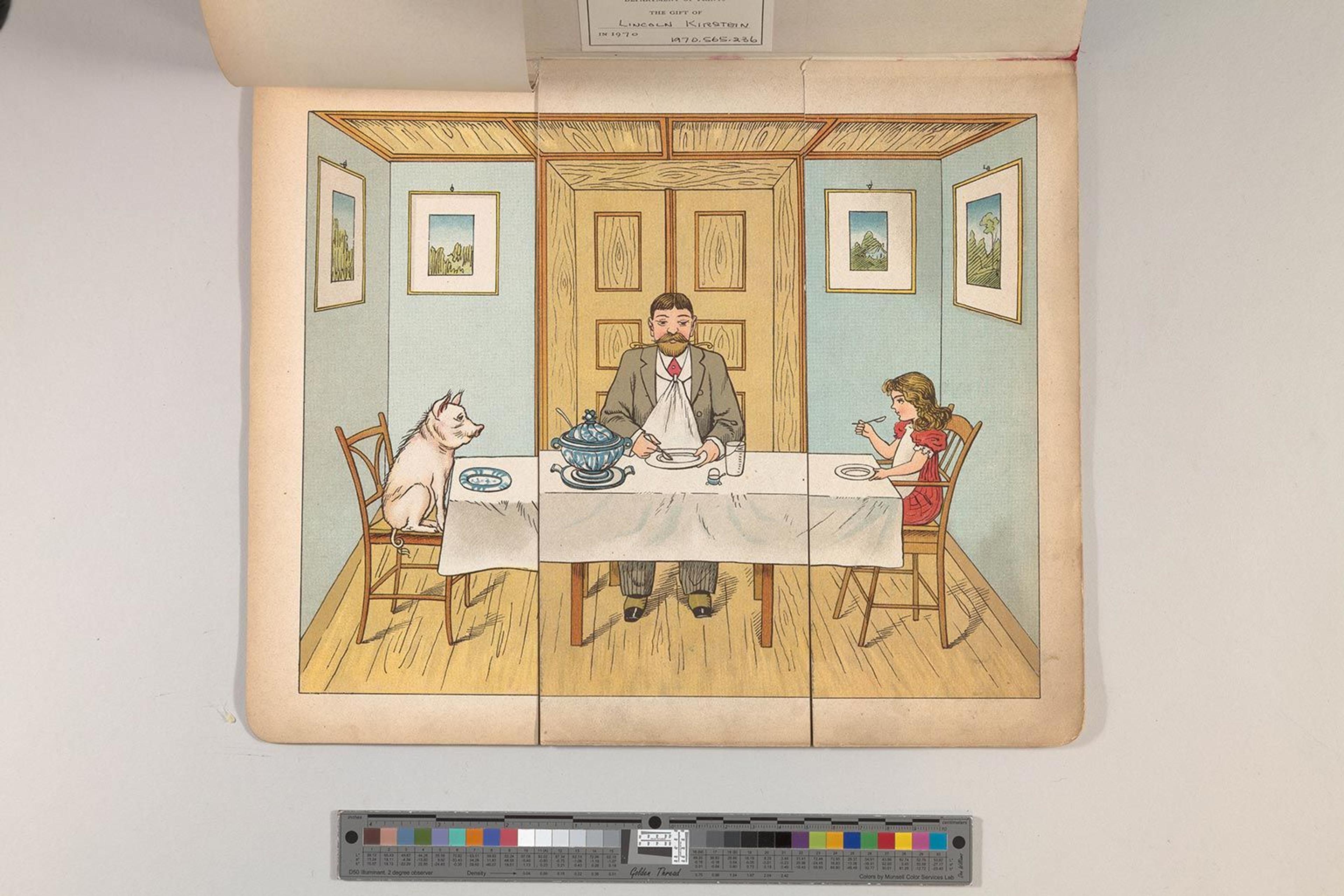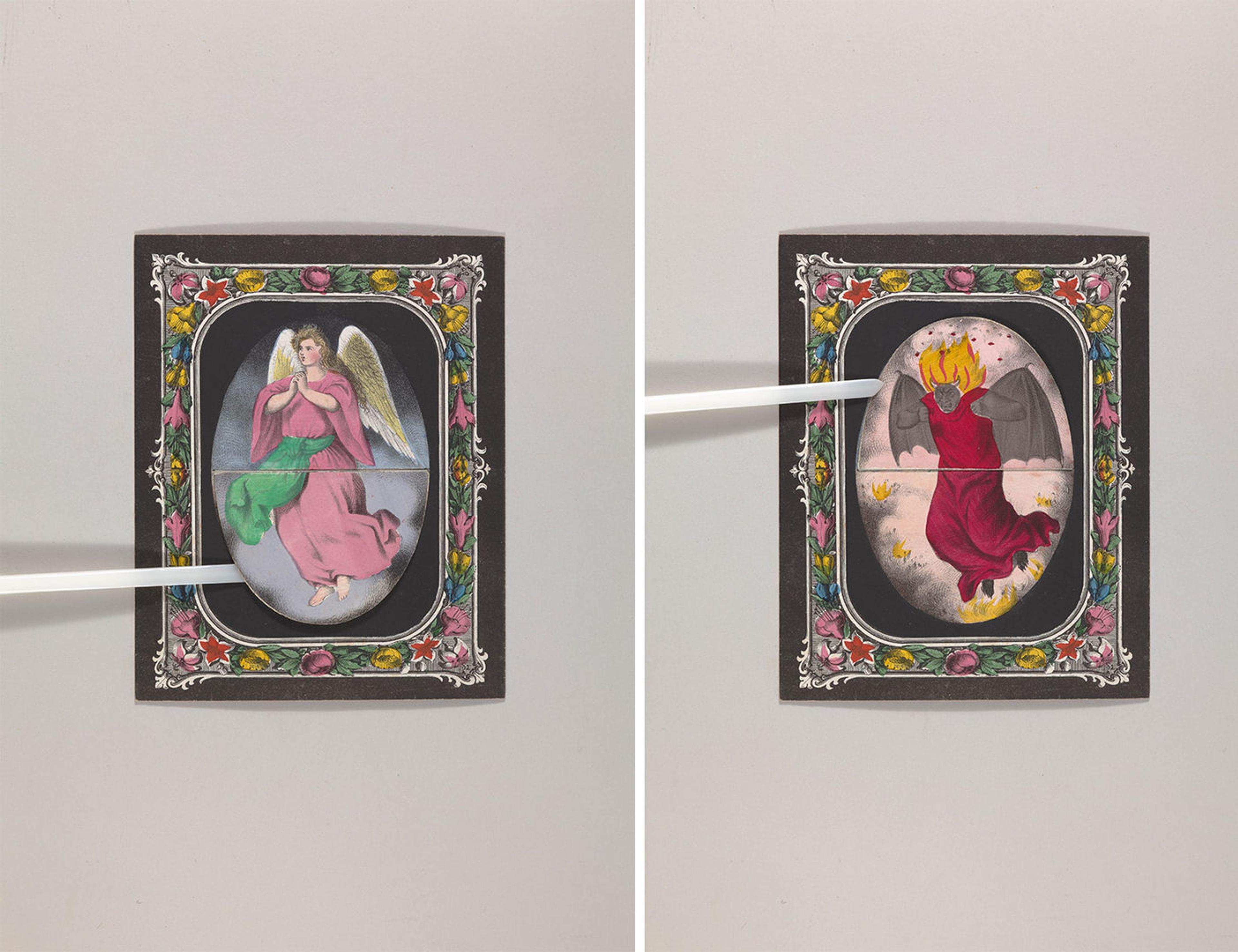Under the generosity of the New York State Grant Program for Conservation and Preservation, I have spent the past seven months treating and housing a group of around one hundred bound volumes from the Department of Drawings and Prints. This years grant focused on French and German children’s books, an area which, as the daughter of a children’s book illustrator, I was particularly excited about. This group has included a wide range of books of all shapes and sizes, from collections of classic fairy tales and fables to educational texts on botany or insects.

A table with diners that change as the flaps are lifted. Da mußt Du lachen!, Lothar Meggendorfer, J.F. Schreiber (Esslingen bei Stuttgart), ca. 1897, color lithographs, 1970.565.236

Pages of different dimensions are employed to illustrate action within a scene. Here, turning the small page at center reveals the exact moment when Sleeping Beauty wakes from her slumber. Neues Marchentheater, Dornröschen [Sleeping Beauty], Otto von Leixner (German, 1847–1907), C. Offterdinger, J. Englehorn , Stuttgart, late nineteenth century, color lithographs, 1970.565.238
Abundant in children’s literature is the theme of transformation. In fables and fairy tales, characters often transform into something or someone else: an ugly duckling into a swan, a frog into a prince, or a neglected orphan into a princess. While working with this group of children’s books, I observed that the idea of transformation occurs not only in subject matter but also in a book’s physical structure and design.

A magic card in which an angel transforms into a devil. Zauberhafte Verwandlungen, Metamorphoses Magiques, Anonymous, German, nineteenth century, Hand colored lithographs, 1972.619.2

Cover and spine of [Blow Book (Magic Book)], nineteenth century, etchings with some hand-coloring, 64.629.12
There are books with flaps that cause a scene to transform as its elements are changed; books with partial pages that, when turned, transform a picture from showing one moment to the next; and a set of magic cards, each bearing a poem on the verso, on which an image transforms into its opposite.

The fore-edge (above) of 64.629.12, showing undulations resulting from handling use; tabs along the fore-edge are visible in the lower image
One book goes even further, promising to transform into a different book entirely. This small late eighteenth or early nineteenth century volume is bound in a brown paper wrapper and lacks any trace of title or publisher’s information. Though formerly cataloged as a coloring book due to the repeating printed and hand-colored images on its pages, this volume is in fact a “blow book,” cleverly engineered to be performed to an audience as a magic trick.
The late magician Ricky Jay, famous both for his sleight of hand and art collection, published an extensive history of the blow book in 1994. In The Magic Magic Book: An Inquiry into the Venerable History & Operation of the Oldest Trick Conjuring Volumes, Designated ‘Blow Books,’ Jay traces the history of this magic book all the way back to the sixteenth century by thoroughly cataloging descriptions of its performance in early texts. Jay cites literature confirming that blow books circulated across Europe and into Asia. Published by The Library Fellows of the Whitney Museum of American Art, The Magic Magic Book is a work of art in and of itself, with a second volume of illustrations by artists such as Vija Celmins and Glenn Lignon that can be performed as a blow book.

An illustration of cats and mice in 64.629.12

An illustration of birds in 64.629.12. The illustrations here appear upside down, as images were printed in both orientations to allow for more possible transformations when the volume was flipped over.
In addition to charting the history of this magic book, Jay describes its format, structure, and method of performance, all of which appear to have remained fairly consistent since the blow book’s appearance. Typically bound in limp bindings or paper wrappers to allow for necessarily forceful handling, blow books consist of a series of repeating images. Staggered and subtle tabs are cut along the fore edge of the volume, corresponding to the pattern of repeating images, so that the performer can selectively flip through the book’s leaves to create the illusion that the same image appears on all of its pages. By moving the thumb’s location to a different tab or turning the volume upside down, while simultaneously blowing on the book to distract the audience, the performer can then flip through the book again, revealing entirely different images on the visible pages. This action gives the appearance that the book’s contents have been transformed. This can be repeated again and again, until all the different images have been revealed. Pages left intentionally blank could then create the illusion that the images have vanished from the book entirely.
The Met’s blow book conforms to Jay’s description and includes images of animals, birds, buildings, male and female figures, and bars of color and pattern. The etched images are hand colored and are done so very consistently across each instance of their appearance. Four slits were cut perpendicularly into the fore edge, with narrow strips of paper removed from the edge, to create five sets of tabs.


Examination of the blow book reveals a history of frequent use and handling—evidence of its performance. Undulations in the text block along the fore edge result from the repeated path of the thumb across the pages (see the above image). Within each tab, the paper curves first to the left and then to the right, and each tab reveals a second set of images when the book is flipped upside down. Handling had also caused some damage to the paper, which was worn and abraded along the fore edge, with many small losses and tears. There were larger tears running horizontally and into the image area of some pages, and there was significant wear to the covers, which were creased and abraded, with losses along the fore edges and spine.
In treating the volume, I sought to stabilize and mend damage without eliminating the traces of its history of handling and use. Especially worn paper along the fore-edge was consolidated; large tears were mended with mulberry fiber paper and wheat starch paste; creases in the paper covers were flattened and mended; and some of the losses in the cover were bridged or filled.
In The Magic Magic Book, Jay describes an early seventeenth century blow book, now held in a private collection, that was rebound in the eighteenth century in stiff vellum binding with thick, heavy boards. Jay points out that this historical rebinding not only obscures but also prevents the book’s function and capacity to be performed. The hard covers and limited opening would make it difficult, if not impossible, to flip through the pages in the manner required to carry out the illusion.

From a conservation perspective, the former misidentification of The Met’s blow book could have had unfortunate consequences. A lack of awareness of the blow book could have lead to treatment decisions that might have obscured the nature of this book’s specific method and history of handling, diminishing it into a strange volume of repeating images—something that hardly seems magical at all.

While, as Jay points out, blow books were originally created to be performed for adult audiences, today they are marketed largely for children as an easy-to-learn magic trick or party favor, with brightly colored, cartoon-like images. It’s no surprise that the idea of a magical, transforming book has persisted across centuries. What reader hasn’t experienced the transformative nature of the book—that simple object which, in the act of reading, turns into story, into experience, into memory, into something entirely different than it was before?
